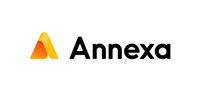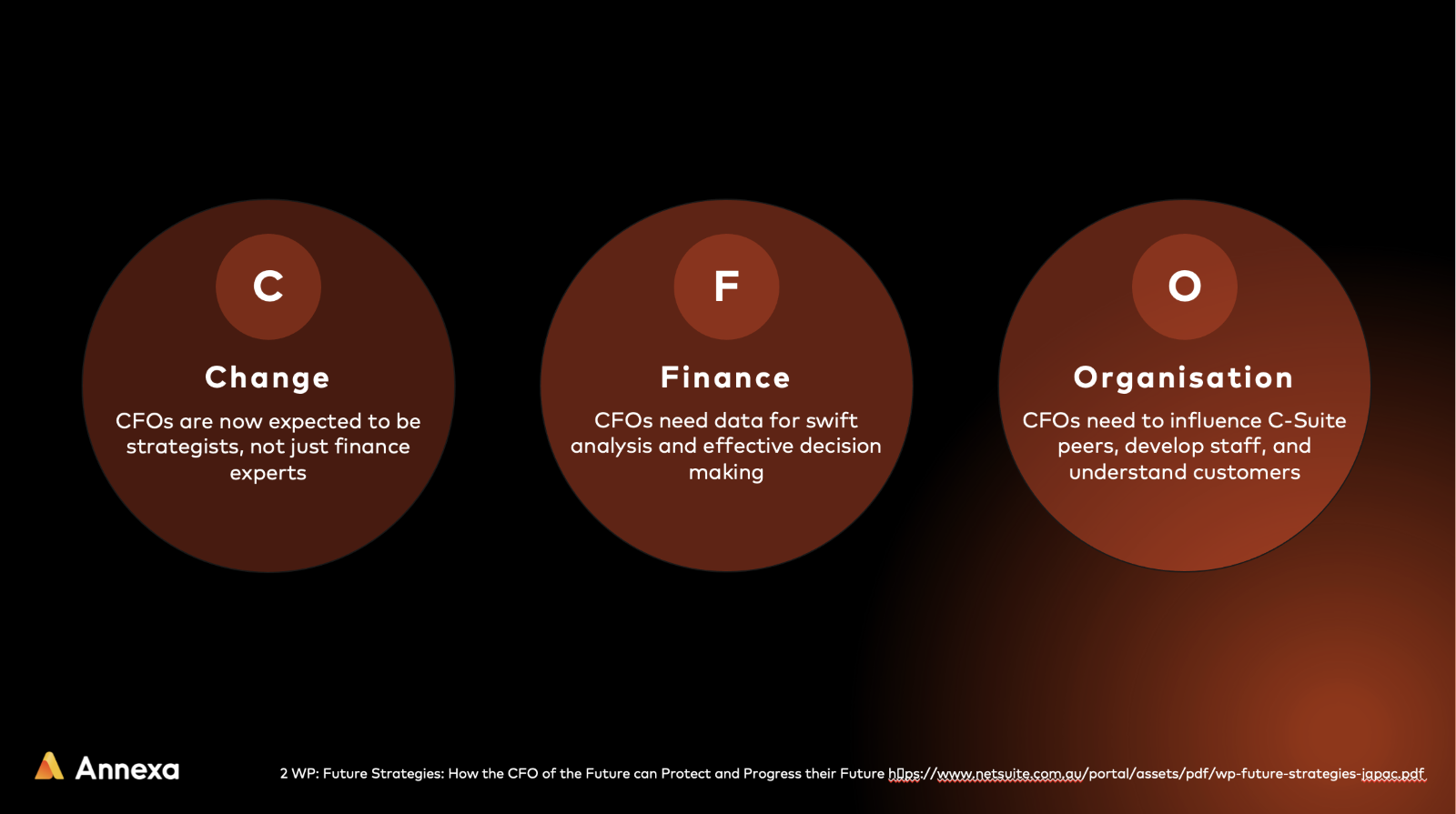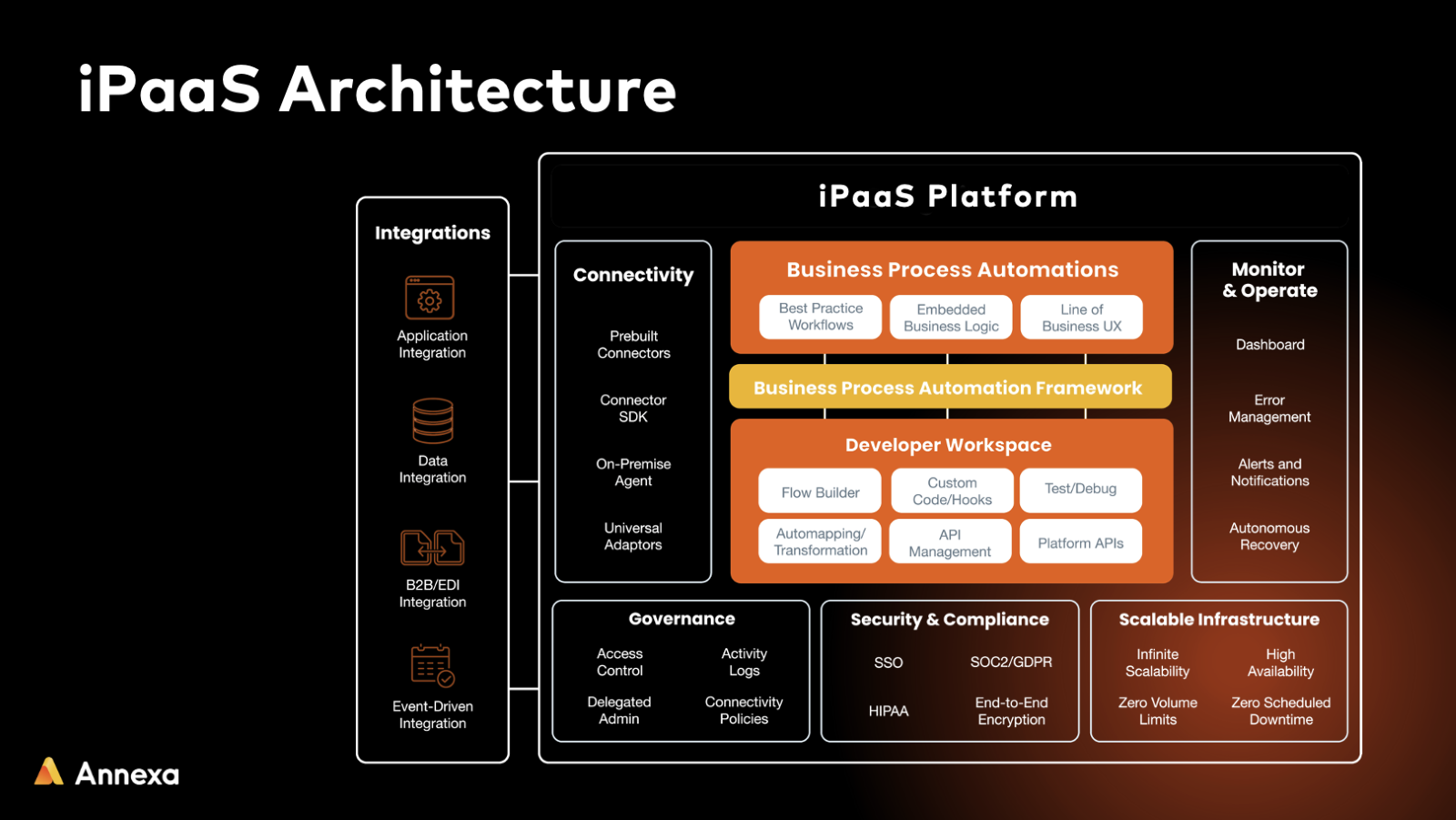Webinar Recap: Digital transformation for skyrocketing financial efficiency
with CPA Australia & Annexa


Speakers
- Host: Kyelie Baxter FCPA, CPA Australia Councillor & Director, IQ Accountants
- Hoss Taher, Senior Project Manager, Annexa
- Jarred Spriggs, Director, Annexa
Webinar in a nutshell
This November, in collaboration with CPA Australia, we hosted a webinar centred on the financial tools essential for boosting financial efficiency. If you're a finance leader keen on driving technology transformation, this is a must-watch. Access the full webinar here, or for a comprehensive breakdown of the topic, scroll down.
The role finance leaders play in tech transformation

As finance leaders shift from conventional finance-focused roles – such as budgeting, accounting, and risk management - to more strategic, technology-driven positions, they are increasingly becoming central players in an organisation’s digital transformation initiatives.
Strategic decision-making | Expertise in financial management when combined with an understanding of digital technologies, positions finance leaders uniquely to guide strategic decisions that align financial goals with technological advancements.
Datafication | The concept of 'datafication' - transforming business processes into data-driven operations - means finance leaders must understand and leverage the vast amounts of data generated by digital technologies to inform, risk assessment, and discover new opportunities.
Influencers of technology adoption | Technology is no longer just supporting the finance function rather it has become a strategic tool. Which makes finance leaders instrumental in identifying and implementing technology solutions that enhance financial efficiency and overall organisational success. More and more, we will see finance leaders acting as a bridge between finance and technology as they collaborate with IT departments, leverage technological trends, and ensure that finance strategies are supported by the right technology.
Drivers for tech transformation

There are a number of primary drivers behind the need for technology transformation in financial operations. The rapid pace of technological change, increasing data volumes, competitive pressures, and evolving customer expectations are all necessitating a continuous assessment and strategic upgrade of technology infrastructure.
Technology architecture: how to identify gaps?

Technology gaps have a significant impact on an organisation's financial visibility and efficiency. Gaps can lead to inefficient processes, data inaccuracies, and hindered decision-making capabilities, ultimately affecting the organisation’s bottom line.
To identify gaps within existing technology architecture, you first need to conduct a thorough analysis of current systems, assessing how well they integrate with each other, their ability to handle current workloads, and their scalability for future growth. Other notable considerations include evaluating the compatibility of current systems with emerging technologies, the ease of data access and analysis, and the ability of systems to support real-time decision-making.
Process automation for finance in action
Financial process automation involves the use of software and technology to automate routine, manual financial tasks to increase efficiency and reduce the likelihood of errors. To identify processes that are ripe for automation. look for tasks that are repetitive, time-consuming, and prone to human error, such as data entry, invoice processing, and reconciliation tasks.

Specifically for finance, the gap analysis should include – amongst many others – an evaluation of automation capabilities in financial processes, the robustness of financial reporting tools, and the integration of financial systems with other business operations.
Pinpointing these gaps will help in prioritising areas for improvement and aligning technology upgrades with strategic business goals.
What does enterprise architecture look like?

An effective enterprise architecture (EA) – such as the example in the screenshot below - integrates various components of a business's technology landscape, including software applications, hardware, and network systems. It's designed to align IT strategy with business goals, ensuring that technology serves as an enabler rather than a constraint.
Ideally, it should be adaptable to changing business needs and scalable as the organisation grows.
Process automation for finance
Customer use case: Automated payment gateway reconciliation for a global retail brand

Traditional reconciliation processes, often manual and time-consuming, involve matching ledger entries with bank statements or other financial records. Automation introduces software solutions that can quickly and accurately perform these matches.
For this customer, data from an external CRM system is integrated into the ERP system, allowing for the automatic recognition and recording of revenue from diverse contracts.
Challenge | This customer was facing complexities when reconciling payments due to the use of diverse payment technologies both online and in physical stores. This included different merchant accounts and payment methods like EFTPOS, Apple Watch, Afterpay, Visa, and MasterCard.
Solution | To address these challenges, Annexa implemented a holistic cloud-based finance ERP system including various financial operation modules, such as accounts payable, inventory management, and warehouse management.
In addition, an integration with an external CRM system allowed for automated revenue recognition from customer contracts. We were then able to consolidate 40 different merchant accounts s payment statements could be processed and reconciled automatically.
Results | The automated solution has successfully reconciled over 15 million transactions for 40 different merchants (and counting), showcasing the efficiency and scalability of the automation solution.
Financial use case: Financial analytics & reporting

The next use case demonstrates the effectiveness of integrating and automating financial reporting systems within an enterprise architecture. This approach simplifies data management but also leverages advanced technologies like machine learning to provide real-time analytics.
Financial challenge | The need for standardised, consistent financial reporting across various business functions, especially in complex enterprise environments with multiple systems and data sources.
Solution | This solution requires an integrated approach where various systems, such as eCommerce platforms and in-store order systems, are connected within an enterprise architecture framework. With the business's financial data integrated, the next step is to automate the financial reporting processes with a goal of standardising reporting across the organisation, ensuring that data from different sources is consolidated into uniform and consistent reports for management. Machine learning algorithms then analyse the consolidated data, providing real-time insights to bolster decision-making capabilities.
Results | In this scenario, automation leads to more efficient and accurate financial reporting processes, reducing manual efforts and errors while the use of machine learning supports real-time financial insights. It all adds up to deeper insights and lower administrative burdens for finance teams.
Financial use case: Financial planning & budgeting

In this scenario we demonstrate how leveraging technology to streamline and automate financial planning and budgeting processes improves efficiency, accuracy, and strategic alignment in its financial operations.
Financial challenge | Disparate systems that rely on a mix of various tools, cause process inefficiencies - particularly in areas of forecasting, budgeting, and board reporting - resulting in a significant drain on resources and time, and overall financial management effectiveness.
Solution | Implementing integrated financial planning and budgeting tools, aligning allows for the consolidation of data from different platforms. automation can then be introduced in key areas like cash forecasting and project cost completion. For example, users are able to run 'what-if' analyses enabling more dynamic and future-proof financial planning, assembling board packs can be automated and the manual workload involved in month-end planning and reporting is slashed.
Results | Automations like these lead to a significant reduction in planning cycle times, better alignment of financial data and reporting and more cohesive decision-making.
Systems integration for greater visibility
Things get a little more technical when we discuss system integration models and best practices, focusing on how to achieve holistic data management and enhanced decision-making capabilities.
Understanding integration models

Point-to-point model
A basic integration where each system is directly connected to every other system it needs to communicate with.
Among the main advantages of point-to-point integration is the ability for IT to build a small-scale integrated system quite quickly. On the flip side, the model is hard to scale and the management of all the integrations gets very demanding when the number of applications grows. For example, to interconnect six modules you need to perform 15 integrations. This results in the so-called star or spaghetti integration.
This approach suits companies that don't have complex business logic and run their operations on just a few software modules. It’s also ideal for businesses aiming at connecting to SaaS applications.
Hub-and-spoke model
A more scalable alternative, this model involves a central hub through which all systems communicate. It simplifies the architecture by reducing direct connections between each system, making it easier to manage and scale.
As opposed to peer to peer, the model brings quite a few benefits to the table including higher scalability. Since every system has only one connection to the central hub, things get better in terms of security and architecture simplicity. However, beware as the centralisation of the hub can become a key bottleneck as the workload increases and the entire infrastructure is dependent on the single integration engine.
The hub-and-spoke model is widely used in eCommerce, financial operations, and payment processing. Plus, it’s a preferable architecture for highly regulated industries that face significant security risks.
Integration Platform as a Service (iPaaS)

This is a set of cloud-based integration solutions mostly used for building and deploying integrations in the cloud.
iPaaS has many advantages. It’s flexible, multi-functional, and scalable. With iPaaS, integration activities are automated, facilitating the connection of systems and databases deployed in any environment and enabling faster project delivery. As far as the shortcomings, there might be security concerns as with any public cloud.
Best practices in system integration
The choice between point-to-point, hub-and-spoke and iPaaS should be based on the organisation's size, complexity, and specific needs.
Meticulous planning is required before choosing a model and implementing any integration project. This includes understanding business needs, the current IT landscape, and future scalability requirements. As well as planning for compatibility issues, data security concerns, and ongoing maintenance and updates.
Q&A section
You can watch the full Q&A below to hear insightful questions covering iPaaS tools, generative AI in automating finance-related processes, ROI of automating finance processes, integration challenges and more.

